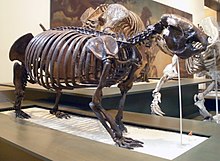加勒比地懶科
| 加勒比地懶科 化石時期:
| |
|---|---|

| |
| 似齧齒加勒比地懶(Megalocnus rodens)全身骨架化石,展於美國自然史博物館 | |
| 科學分類 | |
| 界: | 動物界 Animalia |
| 門: | 脊索動物門 Chordata |
| 綱: | 哺乳綱 Mammalia |
| 目: | 披毛目 Pilosa |
| 亞目: | 食葉亞目 Folivora |
| 科: | †加勒比地懶科 Megalocnidae Presslee et al, 2019 (as family) |
| 屬 | |
| 異名 | |
|
Megalocnoidea Delsuc et al, 2019 | |
加勒比地懶科(學名:Megalocnidae)為已滅絕的地懶,生存於早漸新世至中全新世時期的大安地列斯群島,包括古巴、伊斯帕尼奧拉島及波多黎各,但並不分佈於牙買加。加勒比地懶科下的物種最初與二趾樹懶一同被置於巨爪地懶科下,但近年來針對其線粒體DNA及膠原蛋白序列的研究顯示牠們其實是屬於樹懶亞目的基群,是演化樹上最早與其他樹懶及地懶分家的演化支[1][2]。加勒比地懶科的物種體型與習性上有非常大的差異,體型最大的加勒比地懶屬體重可達200至270公斤(440至600磅)[3],屬完全陸生;而體型最小的Neocnus體型則近似於現存的樹懶,體重不超過10公斤(22磅),推測以樹棲為主[4]。
演化史
[編輯]
一般認為地懶是於約3,300萬年前始新世-漸新世滅絕事件發生的期間自南美洲抵達加勒比海,此時由於面臨冰期而有明顯的海平面下降[5]。加勒比地懶遷移的時間約符合大阿韋斯-安地列斯海嶺(Greater Aves Antilles Ridge)假說,該假說認為由於當時海平面下降,阿韋斯海嶺變成了一座陸橋,使動物得以從大陸上遷移至大安地列斯群島。但這個假說目前缺乏地理學上的直接證據能證明阿韋斯海嶺曾經突出於海平面[6];另外,許多源自於南美洲的動物(例如美洲有袋類及南蹄目)並沒有分佈於大安地列斯群島,這意味着當時可能並沒有形成陸橋[7][4][note 1]。加勒比地區地懶最早的化石證據為發現於波多黎各地層年代屬早漸新世的部分股骨化石[8],其他早於更新世的化石遺骸則包括早中新世時期古巴的Imagocnus[9],以及中新世晚期多明尼加共和國的未定名物種[10]。
分類學
[編輯]加勒比地懶直至今日仍未有明確的分類,尤其是更新世至全新世的物種數量一直存在存疑,有些物種可能為次異名,而其他部分屬的物種數目則可能有所低估[11]。從線粒體DNA的分析研究顯示Acratocnus ye與Parocnus serus於漸新世時期即分家,這代表加勒比地懶科於早期有發生輻射適應。肇因於此,有科學家認為可將加勒比地懶科提升為加勒比地懶總科,並包含Acratocnidae及Parocnidae兩個科[1]。
底下分類係根據懷特與麥克菲於2001年[12]、以及薇諾拉·羅培茲等人於2022年所提出的研究分析[10]:
- 加勒比地懶屬 Megalocnus
- †似齧齒加勒比地懶 M. rodens:古巴,更新世至全新世
- Acratocnus
- †A. odontrigonus:波多黎各,更新世
- †A. ye:伊斯帕尼奧拉島,更新世至全新世
- †A. antillensis:古巴,更新世至全新世
- Mesocnus
- †M. browni:古巴,更新世至全新世
- Parocnus
- Neocnus
- †N. gliriformis:古巴,更新世至全新世
- †N. major:古巴,更新世至全新世
- †N. comes:伊斯帕尼奧拉島,更新世至全新世
- †N. dousman:伊斯帕尼奧拉島,更新世至全新世
- †N. toupiti:伊斯帕尼奧拉島,更新世至全新世
- Imagocnus
- †I. zazae:古巴,中新世早期
有關其他棲息於加勒比地區的地懶,可參見棲息於加勒比地區的披毛目物種。
種系發生學
[編輯]本演化樹係根據於針對地懶及樹懶的線粒體DNA及膠原蛋白序列研究分析[2]:
| 樹懶亞目 Folivora |
| |||||||||||||||||||||||||||||||||||||||||||||||||||||||||||||||
滅絕
[編輯]生存於加勒比地區的地懶滅絕時間約晚於美洲大陸上的地懶物種5,000年。在古巴,加勒比地懶屬約於距今4,700年前滅絕,約為西元前2,700年[14],Parocnus browni約於距今6,250年前滅絕,而在伊斯帕尼奧拉島上的未定名地懶物種則約於距今5,000年前滅絕。加勒比地懶滅絕的時間點約與人類遷徙至加勒比地區的時間相符,推測他們就是導致加勒比地懶滅絕的主因[15]。
註記
[編輯]參考文獻
[編輯]- ^ 1.0 1.1 Delsuc, F.; Kuch, M.; Gibb, G.C.; Karpinski, E.; Hackenberger, D.; Szpak, P.; Martínez, J.G.; Mead, J.I.; McDonald, H.G.; MacPhee, R.D.E.; Billet, G. Ancient Mitogenomes Reveal the Evolutionary History and Biogeography of Sloths. Current Biology. June 2019, 29 (12): 2031–2042.e6 [2023-11-27]. PMID 31178321. doi:10.1016/j.cub.2019.05.043
 . (原始內容存檔於2022-03-23).
. (原始內容存檔於2022-03-23).
- ^ 2.0 2.1 Presslee, S.; Slater, G.J.; Pujos, F.; Forasiepi, A.M.; Fischer, R.; Molloy, K.; Mackie, M.; Olsen, J.V.; Kramarz, A.; Taglioretti, M.; Scaglia, F. Palaeoproteomics resolves sloth relationships. Nature Ecology & Evolution. July 2019, 3 (7): 1121–1130 [2023-11-27]. PMID 31171860. S2CID 174813630. doi:10.1038/s41559-019-0909-z. (原始內容存檔於2023-02-10).
- ^ Couto, C. D. P. (1967). Pleistocene edentates of the West Indies. American Museum novitates; no. 2304.
- ^ 4.0 4.1 Defler, Thomas, Mammalian Invasion of the Caribbean Islands, History of Terrestrial Mammals in South America, Topics in Geobiology 42, Springer International Publishing: 221–234, 2019, ISBN 978-3-319-98448-3, OCLC 1086356172, S2CID 134438659, doi:10.1007/978-3-319-98449-0_11
- ^ Houben, A.J.P.; van Mourik, C.A.; Montanari, A.; Coccioni, R.; Brinkhuis, H. The Eocene–Oligocene transition: Changes in sea level, temperature or both?. Palaeogeography, Palaeoclimatology, Palaeoecology. June 2012,. 335-336: 75–83. Bibcode:2012PPP...335...75H. doi:10.1016/j.palaeo.2011.04.008.
- ^ Ali, Jason R. Colonizing the Caribbean: is the GAARlandia land-bridge hypothesis gaining a foothold?: Commentary. Journal of Biogeography. March 2012, 39 (3): 431–433. S2CID 84576035. doi:10.1111/j.1365-2699.2011.02674.x.
- ^ Ali, Jason R.; Hedges, S. Blair. Hoorn, Carina , 編. Colonizing the Caribbean: New geological data and an updated land‐vertebrate colonization record challenge the GAARlandia land‐bridge hypothesis. Journal of Biogeography. November 2021, 48 (11): 2699–2707. ISSN 0305-0270. S2CID 238647106. doi:10.1111/jbi.14234
 (英語).
(英語).
- ^ MacPhee, R.D.E.; Iturralde-Vinent, M.A. Origin of the Greater Antillean land mammal fauna, 1: New Tertiary fossils from Cuba and Puerto Rico. American Museum Novitates. 1995, (3141): 1–31. hdl:2246/3657.
- ^ MacPhee, R.D.E.; Iturralde-Vinent, M.A. & Gaffney, E.S. Domo de Zaza, an early Miocene vertebrate locality in south-central Cuba, with notes on the tectonic evolution of Puerto Rico and the Mona Passage. American Museum Novitates. 2003, (3394): 1–42 [2023-11-27]. S2CID 55615855. doi:10.1206/0003-0082(2003)394<0001:DDZAEM>2.0.CO;2. hdl:2246/2820. (原始內容存檔於2023-04-04).
- ^ 10.0 10.1 Viñola-Lopez, Lazaro W.; Suárez, Elson E. Core; Vélez-Juarbe, Jorge; Milan, Juan N. Almonte; Bloch, Jonathan I. The oldest known record of a ground sloth (Mammalia, Xenarthra, Folivora) from Hispaniola: evolutionary and paleobiogeographical implications. Journal of Paleontology. May 2022, 96 (3): 684–691. Bibcode:2022JPal...96..684V. ISSN 0022-3360. S2CID 245401150. doi:10.1017/jpa.2021.109
 (英語).
(英語).
- ^ 11.0 11.1 McAfee, R.K.; Beery, S.M. Intraspecific variation of Megalonychid sloths from Hispaniola and the taxonomic implications. Historical Biology. 2019-06-04, 33 (3): 371–386. S2CID 195403443. doi:10.1080/08912963.2019.1618294.
- ^ White, J.L.; MacPhee, R.D.E. The sloths of the West Indies: a systematic and phylogenetic review. Woods, C. A.; Sergile, F. E. (編). Biogeography of the West Indies: Patterns and Perspectives. Boca Raton, London, New York, and Washington, D.C.: CRC Press. 2001: 201–235 [2023-11-27]. ISBN 978-0-8493-2001-9. doi:10.1201/9781420039481-14. (原始內容存檔於2023-03-05).
- ^ McAfee, Robert; Beery, Sophia; Rimoli, Renato; Almonte, Juan; Lehman, Phillip; Cooke, Siobhan. New species of the ground sloth Parocnus from the late Pleistocene-early Holocene of Hispaniola. Vertebrate Anatomy Morphology Palaeontology. 2021-08-31, 9 (1) [2023-11-27]. ISSN 2292-1389. doi:10.18435/vamp29369
 . (原始內容存檔於2023-04-04) (英語).
. (原始內容存檔於2023-04-04) (英語).
- ^ MacPhee, R. D. E.; Iturralde-Vinent, M. A.; Vázquez, Osvaldo Jiménez. Prehistoric Sloth Extinctions in Cuba: Implications of a New "Last" Appearance Date. Caribbean Journal of Science. January 2007, 43 (1): 94–98. ISSN 0008-6452. S2CID 56003217. doi:10.18475/cjos.v43i1.a9 (英語).
- ^ Steadman, D. W.; Martin, P. S.; MacPhee, R. D. E.; Jull, A. J. T.; McDonald, H. G.; Woods, C. A.; Iturralde-Vinent, M.; Hodgins, G. W. L. Asynchronous extinction of late Quaternary sloths on continents and islands. Proceedings of the National Academy of Sciences. 2005-08-16, 102 (33): 11763–11768. Bibcode:2005PNAS..10211763S. ISSN 0027-8424. PMC 1187974
 . PMID 16085711. doi:10.1073/pnas.0502777102
. PMID 16085711. doi:10.1073/pnas.0502777102  (英語).
(英語).





